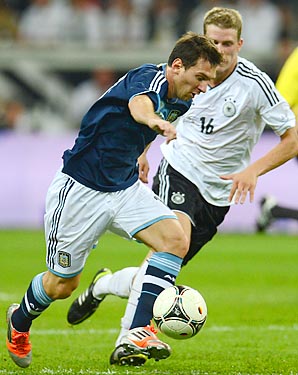Sabella meshes Argentina's abundance of attacking talent
Alejandro Sabella, who replaced Batista after Argentina's quarter-final exit in the Copa America, is open about the strengths and weaknesses of his side. "Not to offend anyone on my team, but it is what it is, we are better up front," Sabella told the website Mundo Albiceleste last month. "In Messi, we have the best player in the world and we also have Higuain, Di Maria and Aguero. There's no doubt that we are better equipped in attack than in defense. And when I say that, I don't mean to offend anyone on my team, but it is what it is."
But where his predecessors unbalanced the side, overloading it with attacking players, Sabella has responded with the sort of hard-headed pragmatism he demonstrated when leading Estudiantes to the Copa Libertadores title in 2009. His team structure is essentially there to provide a platform for Messi.
Messi, genius that he is, presents a problem at international level. His performances for Barcelona mean he stands already, at the age of 25, near the summit of the all-time pantheon. At Barcelona, though, he plays in a very specific way, as a false nine who drops deep off the front line to link the tiki-taka as players move from deep or wide positions into the space he has vacated. It is a devastating style of football when it works, but it is a hugely difficult style of football to introduce -- which is why, despite numerous attempts, no other side in the world, not even Spain, plays in that way. It takes players of great imagination, game intelligence and technical ability and, even if they are available, it takes time. Mutual understanding, the movement that seems instinctive, is developed over hours and hours on the training pitch. At international level there simply isn't time to produce that same cohesion, which is why Batista's claim before the Copa America that his Argentina was going to play like Barcelona was vainglorious. If that really was his plan, and not a sop offered to public opinion, he was always doomed to failure.
Batista tried Messi as a false nine but that meant no place for Higuain and didn't work as there were no breakers from midfield. So, he brought Higuain back and moved Messi to the right. That didn't work either: as Messi cut inside, there was no overlapping full-back tearing up outside him to draw a defender or provide a passing option. The lesson was clear: at international level, with the other players in the Argentina squad, Messi has to be used in a different way to how he is used at Barcelona.
Against Ecuador at the beginning of June, in Argentina's last World Cup qualifier, Messi was deployed almost as an old-fashioned number 10, operating behind Higuain and Aguero. It may be that that is how Sabella intends to play against Paraguay in Cordoba on Friday -- although Lavezzi would presumably come in for the injured Aguero who, it seems may be available for the match in Peru next week. "I love the potential of the team with three forwards," Sabella said, "but I have to see our opponent. I love watching Messi and Aguero-Higuain. I want to play them all but the team has a general context."
But what is more interesting is the way Argentina lined up in the two games they have played since then, against Brazil and against Germany. Both games were won, Brazil beaten 4-3 in thrilling fashion at the MetLife Stadium, Germany overcome by a rather more comfortable 3-1 in Frankfurt after their goalkeeper Ron-Robert Zieler had been sent off. In both of those games -- games in which Argentina could not be guaranteed domination of possession, which they surely will be against a defensive Paraguay -- Higuain played as the main striker with Messi just behind him, backed up by two banks of four. It's solid, conservative and, seemingly, effective.
In both games Javier Mascherano and Fernando Gago, both natural ball-winners, operated at the back of midfield. There is a bite and an aggression about this Argentina -- not the petulance that came to dog them in the Copa America, but something far more purposive. Mascherano is suspended for the Paraguay game and likely to be replaced by Rodrigo Brana. On the flanks, Sabella opted for Di Maria and, controversially, Jose Sosa. Although he spent three seasons at Bayern Munich, Sosa is far less glamorous than many of the other options, a shuttler with a creative bent who balances the more languid skills of Di Maria. He is dogged rather than spectacular, but that is how Sabella wants it.
This is his Argentina: he has turned a strength back into a strength. The vast array of forwards became a burden for his predecessors but he has the clear-sightedness to see those resources in terms of depth rather than breadth. Anybody can imagine an ideal Argentina in which half a dozen great creators weave wonderful tapestries of sublime attacking football; Sabella seems to be producing something much more real, something that works not just in theory but in practice.





